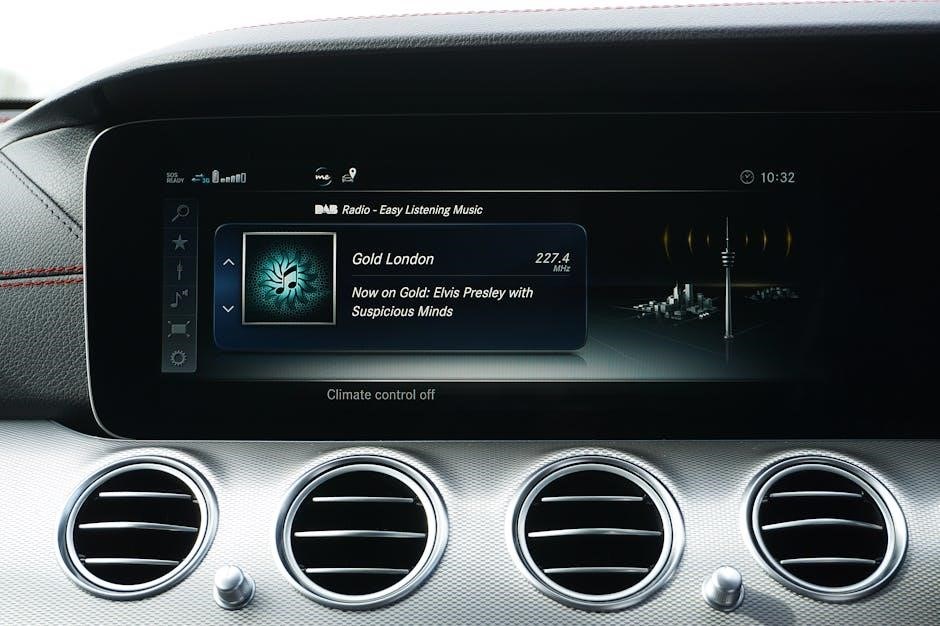wii operations manual troubleshooting
The Wii Operations Manual provides essential troubleshooting guides for resolving common issues, ensuring optimal performance and extending the console’s lifespan. It covers disc errors, power problems, and Wii Remote connectivity, offering step-by-step solutions for a smoother gaming experience.
1.1 Importance of Regular Wii Maintenance
Regular Wii maintenance is essential for preventing issues and ensuring smooth operation. Proper care extends the console’s lifespan, reduces errors, and enhances gaming performance. Key practices include cleaning discs, avoiding scratches, and storing components correctly. Addressing power issues promptly and ensuring correct placement of accessories like the Sensor Bar prevent interference. Following the Wii Operations Manual’s guidelines helps maintain optimal functionality and avoids common problems. Consistent upkeep ensures a seamless gaming experience and prolongs the system’s reliability, making it a crucial part of owning a Wii console.
1.2 Overview of Common Wii Issues and Solutions
The Wii often encounters issues like disc errors, power malfunctions, and connectivity problems with the Wii Remote. These problems can disrupt gameplay and system functionality. Solutions typically involve resetting the AC adapter, cleaning discs, or synchronizing remotes. The Wii Operations Manual provides detailed troubleshooting steps, such as checking input settings or resolving sensor bar interference. Addressing these issues promptly ensures optimal performance and extends the console’s lifespan. Regular maintenance, as outlined in the manual, helps prevent recurring problems and keeps the Wii running smoothly for an uninterrupted gaming experience. Consulting the manual is the first step in diagnosing and resolving these common issues effectively.
Disc-Related Troubleshooting
Disc issues, such as games not being recognized or read, are common Wii problems. Cleaning the disc, checking orientation, and ensuring compatibility often resolve these issues quickly.
2.1 How to Clean a Wii Disc Properly
Cleaning a Wii disc is essential for maintaining optimal performance. Start by gently removing loose debris with a soft, dry cloth. For stubborn smudges or fingerprints, dampen a clean cloth with distilled water, wipe from the center outward, and avoid circular motions. Never use harsh chemicals, abrasive materials, or insert the disc into cleaning devices. Allow the disc to air dry before reinserting it into the Wii console. Regular cleaning prevents read errors and ensures smooth gameplay. Always handle discs by the edges to avoid leaving fingerprints or smudges. Refer to the Wii Operations Manual for additional troubleshooting tips if issues persist.
2.2 What to Do If the Disc Is Not Recognized
If the Wii console does not recognize a disc, first ensure the disc is inserted correctly with the label facing right. Check for dirt or scratches and clean the disc gently with a soft cloth. Restart the Wii console and try the disc again. If the issue persists, verify that the disc is compatible with the Wii system. For further assistance, consult the Wii Operations Manual or visit the Nintendo Support Website for detailed troubleshooting steps. This will help resolve the issue and restore proper disc recognition for uninterrupted gameplay.
2.3 Fixing Scratched or Damaged Discs
If a Wii disc is scratched or damaged, start by cleaning it with a soft, dry cloth in a circular motion from the center outward. Inspect the disc for deep scratches or cracks, which may require professional refinishing or replacement. Ensure the disc is properly inserted with the label facing right. If the issue persists, try the disc in another Wii console to confirm it’s not a console problem. For severe damage, consider purchasing a replacement disc. Regularly cleaning and handling discs carefully can prevent such issues. Refer to the Wii Operations Manual for additional troubleshooting tips to restore gameplay functionality.
Wii Console Power Issues
Power issues often occur due to faulty AC adapters or outdated firmware. Reset the AC adapter by unplugging it for 30 seconds, then reconnecting. Check for loose connections and ensure the power cord is securely plugged in. If the console still doesn’t turn on, refer to the Wii Operations Manual for advanced troubleshooting steps or contact Nintendo Support for further assistance. Regular maintenance and proper handling can prevent such issues, ensuring consistent performance and longevity of your Wii console.
3.1 Why the Wii Console Might Not Turn On
The Wii console may fail to turn on due to power supply issues, such as a malfunctioning AC adapter or faulty internal components. Ensure the AC adapter is properly plugged into both the console and the power outlet. Check for any visible damage or fraying on the adapter. If the issue persists, try resetting the AC adapter by unplugging it for at least 30 seconds. Additionally, ensure the console is placed in a well-ventilated area to avoid overheating. If none of these steps resolve the problem, consult the Wii Operations Manual or contact Nintendo Support for further assistance.
3.2 Resetting the Wii AC Adapter
To reset the Wii AC adapter, unplug it from both the console and the power outlet. Allow it to sit for at least 30 seconds to discharge any residual power. After this period, reconnect the adapter to both the console and the outlet. Ensure all connections are secure and free from damage or obstruction. If the issue persists, inspect the adapter for visible damage or fraying. If damaged, replace it with an official Nintendo AC adapter. This process often resolves power-related issues and ensures proper console functionality. Always refer to the Wii Operations Manual for detailed instructions.
3.3 Troubleshooting Power Supply Problems
To address power supply issues with your Wii, start by ensuring the AC adapter is securely connected to both the console and the power outlet. If the console doesn’t turn on, check the outlet for functionality by plugging in another device. Inspect the power cord for visible damage or fraying; replace it if necessary. If the issue persists, try using a different outlet or resetting the AC adapter by unplugging it for 30 seconds. If the problem remains unresolved, consult the Wii Operations Manual or contact Nintendo Support for further assistance. Always use official Nintendo accessories to maintain compatibility and safety.

Wii Remote Troubleshooting
Address common Wii Remote issues like unresponsive buttons or synchronization problems. Ensure proper battery installation, check for interference, and consult the manual for advanced solutions.
4.1 Synchronizing the Wii Remote with the Console
Syncing the Wii Remote with your console ensures seamless gameplay. Open the SD Card slot on the Wii, press and release the SYNC button. On the remote, remove the battery cover and press the SYNC button until the Player LED blinks. Once synced, the LED will stay lit. If issues persist, reset the remote by inserting a pin into the small hole on the back. Ensure batteries are fresh and no interference is present. Proper synchronization is key to optimal performance, eliminating connection dropouts and input delays during play.
4.2 What to Do If the Wii Remote Buttons Are Not Responding
If Wii Remote buttons aren’t responding, check for debris or dirt. Clean the buttons with a soft cloth and isopropyl alcohol. Ensure batteries are fresh or try new ones. Resync the remote by pressing the SYNC button on both the console and remote. If issues persist, perform a reset by inserting a pin into the small hole on the back. Avoid using damaged or third-party accessories. Consult the Wii Operations Manual for detailed troubleshooting steps. Addressing button malfunctions promptly ensures uninterrupted gaming and optimal control responsiveness.
4.3 Solving Wii Remote Battery Life Issues
To address Wii Remote battery life issues, use high-quality alkaline batteries and avoid mixing old and new ones. Turn off the remote when not in use and reduce motion controls to conserve power. Clean contacts regularly with a soft cloth to ensure proper connection. Replace batteries promptly when low. If using rechargeable batteries, charge them fully before use. Refer to the Wii Operations Manual for additional tips on optimizing battery performance and extending the life of your Wii Remote for a seamless gaming experience.

Sensor Bar Issues
The sensor bar is crucial for Wii Remote accuracy. Ensure it is properly connected and placed. Avoid obstructions and excessive light exposure to maintain optimal performance.
5.1 How to Fix a Malfunctioning Sensor Bar
First, ensure the sensor bar is correctly plugged into the Wii console. If issues persist, check for dirt or debris and clean the sensor bar gently with a soft cloth. Avoid exposing it to direct sunlight or bright light sources, as this can interfere with its functionality. If the sensor bar is damaged, consider replacing it to restore accurate Wii Remote tracking and gameplay performance. Refer to the Wii Operations Manual for detailed troubleshooting steps and maintenance tips to resolve sensor bar malfunctions effectively.
5.2 Best Placement for the Sensor Bar
For optimal performance, place the sensor bar directly above or below your TV, centered and at the same height as the Wii Remote’s aiming position. Ensure it is aligned with the Wii Remote’s line of sight to avoid interference. The sensor bar should be at least 2-3 feet above the floor to minimize obstructions. Avoid placing it near reflective surfaces or bright light sources, as this can disrupt its functionality. Clean the sensor bar regularly with a soft cloth to remove dust or debris. Proper placement ensures accurate Wii Remote tracking and enhances gaming accuracy. Refer to the Wii Operations Manual for detailed placement guidelines.
5.3 Troubleshooting Sensor Bar Interference
If the sensor bar is malfunctioning due to interference, check for nearby light sources, such as direct sunlight or bright lamps, which can disrupt its operation. Ensure the sensor bar is placed away from reflective surfaces or electronic devices emitting infrared signals. Clean the sensor bar with a soft cloth to remove dust or debris. If issues persist, try repositioning the sensor bar or using an extension cable to optimize its placement. Verify that the sensor bar is properly connected to the Wii console. Refer to the Wii Operations Manual for detailed troubleshooting steps to resolve interference-related problems effectively.
Wii Remote Plus Specific Issues
The Wii Remote Plus may face motion control inaccuracies or extra light source sensing problems. Consult the Wii Operations Manual for specific troubleshooting steps to resolve these issues effectively.
6.1 Wii Remote Plus Troubleshooting Steps
For Wii Remote Plus issues, start by resetting the remote: remove batteries, wait 30 seconds, and reconnect. Ensure no external light sources interfere with motion controls. If synchronization fails, re-sync the remote by pressing the SYNC button on both the console and remote. Check for physical damage or dirt on sensors. Update firmware if available. Consult the Wii Operations Manual for detailed steps to address motion control inaccuracies or extra light sensing problems. Persistent issues may require contacting Nintendo Support for further assistance or potential hardware repair.
6.2 Resolving Motion Control Problems
Motion control issues with the Wii Remote Plus can often be resolved by recalibrating the device. Ensure the Sensor Bar is properly connected and placed. Reduce interference from direct sunlight or bright objects. Restart the Wii console and resync the remote. Check for firmware updates. If problems persist, reset the remote by removing batteries for 30 seconds. Clean the sensor lens with a soft cloth; Adjust the Wii Sensor Bar placement for optimal signal reception. Refer to the Wii Operations Manual for detailed calibration steps and troubleshooting guides to restore accurate motion controls.
6.3 Extra Light Source Sensing Issues
Extra light sources can interfere with the Wii Remote Plus, causing erratic motion control. Ensure the Sensor Bar is clear from direct sunlight or bright artificial lights. Avoid placing the Wii near light sources like lamps or LEDs. Use the Wii Remote Plus in a well-lit room but away from direct glare. If issues persist, reposition the Sensor Bar or use an extension cable. Restart the console and resync the remote. Check for firmware updates and refer to the Wii Operations Manual for additional troubleshooting steps to eliminate light interference and restore smooth gameplay.

Connecting Wii to TV
Connect the Wii to your TV using AV cables or an HDMI converter for optimal video quality. Ensure the TV is set to the correct input channel for a stable connection and clear display. Refer to the Wii Operations Manual for detailed setup instructions and troubleshooting common connection issues to enjoy a seamless gaming experience.
7.1 HDMI vs. AV Cables: Which to Use
When connecting your Wii to a TV, choosing the right cable is crucial. HDMI cables provide superior video quality, supporting high-definition output, while AV cables offer standard definition and are compatible with older TVs. The Wii natively supports AV cables, but for HDMI connectivity, an adapter is required. For the best visual experience, opt for HDMI if your TV supports it. Otherwise, AV cables remain a reliable option. Ensure the selected cable is of high quality to avoid signal degradation. Refer to the Wii Operations Manual for detailed instructions on connecting and troubleshooting cable-related issues to ensure optimal performance and clarity.
7.2 Why the Wii Might Not Display on the TV
If the Wii isn’t displaying on your TV, start by ensuring all cables are securely connected. Verify the AV or HDMI cables are properly plugged into both the Wii and the TV. Check the TV’s input settings to confirm it’s set to the correct channel for the Wii. If using an HDMI adapter, ensure it’s compatible with your Wii model. Loose connections or incorrect TV input settings are common causes. Additionally, verify the Wii is powered on and the disc is properly inserted. If issues persist, consult the Wii Operations Manual or Nintendo’s support website for further troubleshooting steps to resolve the display problem effectively.
7.3 Troubleshooting No Signal Issues
If your TV displays a “No Signal” message, begin by checking all AV or HDMI connections between the Wii and the TV. Ensure the cables are firmly plugged in and not damaged. Next, verify that the TV is set to the correct input channel corresponding to the Wii’s connection. Restart both the Wii and the TV to reset the connection. If the issue persists, try using a different cable or port on the TV. If no signal is detected even after these steps, refer to the Wii Operations Manual or Nintendo’s support site for advanced troubleshooting options to resolve the connection problem.

Wii Menu and Channels
The Wii Menu offers various channels for games, apps, and settings. Troubleshooting channel-related issues often involves updating system software or re-syncing the Wii Remote for proper functionality.
8.1 Why the Wii Menu Screen Might Not Appear
If the Wii Menu screen fails to appear, ensure the console is properly connected to the TV using the correct AV cables. Check the TV input settings to confirm they match the Wii’s output. A loose or damaged cable could cause the issue. Additionally, ensure the Wii is powered on and the disc is inserted correctly. If the problem persists, reset the AC adapter by unplugging it for 30 seconds, then reconnect and try again. Refer to the Wii Operations Manual for detailed troubleshooting steps to resolve the issue effectively.
8.2 Setting Up Channels Correctly
Setting up Wii channels correctly ensures smooth navigation and functionality. Start by accessing the Wii Menu and selecting the “Wii Settings” option. From there, choose “Channels” and select “Add Channels” to install or update existing channels. Ensure your internet connection is stable for online channels. If a channel fails to load, check for system updates or reinstall the channel. Refer to the Wii Operations Manual for specific instructions on organizing and managing channels effectively to enhance your gaming and entertainment experience.
8.3 Fixing Channel-Related Errors
If a Wii channel fails to load or displays an error, start by checking for system updates in the Wii Settings. Ensure your internet connection is stable and functioning properly. If the issue persists, try reinstalling the channel by deleting it and redownloading it from the Wii Shop Channel. For corrupted data, clear the cache in the Wii Settings under “Data Management.” If channels freeze or crash, restart the console and attempt to reload the channel. Refer to the Wii Operations Manual for detailed troubleshooting steps, or visit the Nintendo Support Website for additional assistance.

Nunchuk and Other Accessories
Resolving common issues with the Nunchuk and other Wii accessories is crucial for optimal gaming performance. This section covers synchronization problems, connectivity errors, and physical damage repair, providing detailed troubleshooting steps to ensure seamless gameplay.
9.1 Nunchuk Not Responding: What to Do
If the Nunchuk isn’t responding, ensure it’s properly synced with the Wii. Check the connector for dirt or damage and clean it gently. Restart the Wii console and re-sync the Nunchuk by removing the battery, waiting a few seconds, and reinserting it. If issues persist, try using the Nunchuk with another Wii Remote or replace the batteries. For severe damage, contact Nintendo support or refer to the Wii Operations Manual for further troubleshooting steps to restore functionality.
9.2 Syncing Issues with Accessories
Experiencing syncing issues with Wii accessories like the Nunchuk or Wii Remote? Ensure the console is powered on and in sync mode. Remove any batteries, wait 30 seconds, then reinstall them. Press the sync button on both the accessory and the Wii. If problems persist, check for interference from other devices or reset the AC adapter as outlined in the Wii Operations Manual. For persistent issues, refer to the troubleshooting section or contact Nintendo support for further assistance to resolve connectivity problems effectively.
9.3 Troubleshooting Third-Party Accessories
Third-party Wii accessories may occasionally cause compatibility issues. Ensure the accessory is compatible with your Wii model. Try resetting the accessory or updating its firmware if available. Disconnect and reconnect the accessory to test functionality. If issues persist, consult the accessory’s manual or contact the manufacturer for support. Some third-party devices may require specific synchronization steps not covered in the Wii Operations Manual. Testing the accessory on another Wii console can help determine if the issue is with the accessory or the console. For unresolved problems, refer to the manufacturer’s troubleshooting guide or seek assistance from their customer service team.

Using the Wii Operations Manual
The Wii Operations Manual provides comprehensive guidance for setup, troubleshooting, and maintenance. It includes detailed instructions, safety precautions, and solutions for common issues, ensuring optimal Wii performance and longevity.
10.1 Navigating the Wii Operations Manual
Navigating the Wii Operations Manual is straightforward with its organized structure. The manual begins with a table of contents, allowing users to quickly locate specific sections. Key areas include system setup, troubleshooting, and maintenance. Each section is detailed with clear instructions and visual guides to ensure ease of understanding. The manual also highlights important safety precautions and warranty information. By referencing the manual, users can efficiently diagnose and resolve common issues, such as disc errors or connectivity problems, ensuring optimal Wii performance and extending its lifespan. This makes it an invaluable resource for both new and experienced users.
10.2 Key Sections of the Wii Manual for Troubleshooting
The Wii manual contains dedicated sections for troubleshooting, making it easier to address specific issues. Pages 28-30 focus on common problems like disc recognition errors and connectivity issues, offering practical solutions. The manual also covers power-related troubles, such as console startup failures, with detailed reset procedures. Additionally, it addresses Wii Remote and Sensor Bar malfunctions, providing synchronization tips and interference fixes. These sections are designed to guide users through diagnosing and resolving problems efficiently, ensuring minimal downtime and optimal gaming experience. Regularly referencing these sections can help users maintain their Wii system effectively.
10.3 How to Download the Wii Operations Manual PDF
Downloading the Wii Operations Manual PDF is a straightforward process. Visit the official Nintendo website and navigate to the support section. Select the Wii console from the product list, then choose the “Manuals & Guides” option. Here, you’ll find links to download the PDF version of the Wii Operations Manual. Ensure you select the correct model, such as RVL-001 or RVK-101, to match your console. Once downloaded, the manual provides easy access to troubleshooting guides, system setup instructions, and warranty information, making it an invaluable resource for resolving issues and maintaining your Wii system effectively.
Online Troubleshooting Resources
Explore online resources for Wii troubleshooting, including Nintendo’s official support website, forums, and community-driven repair guides, to address various console and accessory issues effectively.
11.1 Nintendo Support Website: Key Resources
Nintendo’s official support website offers comprehensive troubleshooting guides, FAQs, and downloadable manuals for Wii consoles. Users can access detailed solutions for disc errors, connectivity issues, and hardware malfunctions. The website also provides links to repair services and customer support contacts. Additionally, it features step-by-step instructions for syncing remotes, resetting systems, and addressing power-related problems. Regular updates ensure users have the latest information to resolve common and emerging issues efficiently. This resource is indispensable for diagnosing and fixing Wii-related problems, making it a go-to for both novice and experienced users seeking reliable solutions.
11.2 Wii Troubleshooting Guides on Official Forums
Nintendo’s official forums host a wealth of community-driven troubleshooting guides tailored for Wii consoles. These forums feature discussions and solutions from experienced users and moderators, addressing issues like disc recognition, remote synchronization, and sensor bar problems. Users can find detailed workarounds, error code explanations, and repair tips shared by the community. The forums also archive common fixes and updates, providing a collaborative space for resolving Wii-related issues. This resource complements the official manual, offering real-world solutions and insights from fellow gamers and technical experts, enhancing the troubleshooting experience.
11.3 Community-Driven Wii Repair Guides
Community-driven Wii repair guides offer detailed, user-generated solutions for common issues, often beyond official resources. Forums like Reddit and YouTube host tutorials for DIY repairs, such as fixing scratched discs, repairing worn-out remotes, and resolving sensor bar malfunctions. These guides frequently include step-by-step photos, videos, and part recommendations, making complex fixes accessible. Users share personal experiences, workarounds, and creative solutions, providing diverse perspectives on troubleshooting. Specialized communities also focus on hardware modifications and advanced repairs, ensuring a comprehensive resource for Wii owners seeking cost-effective, hands-on fixes. These grassroots efforts complement official support, offering unique insights and practical advice for enthusiasts.

Common Wii Error Messages
The Wii console displays specific error messages to indicate issues, such as disc read errors, system failures, or connectivity problems. These messages often direct users to the Wii Operations Manual or support websites for solutions. Common errors include the ” Unable to Read the Disc” message, which suggests problems with the disc or the optical drive, and system crashes during gameplay. Additionally, errors like “No Signal” typically relate to TV connection issues. Understanding these error codes helps users identify the root cause and apply the appropriate fix, ensuring smoother gameplay and optimal console performance. Regular maintenance can prevent many of these issues from occurring.

























































